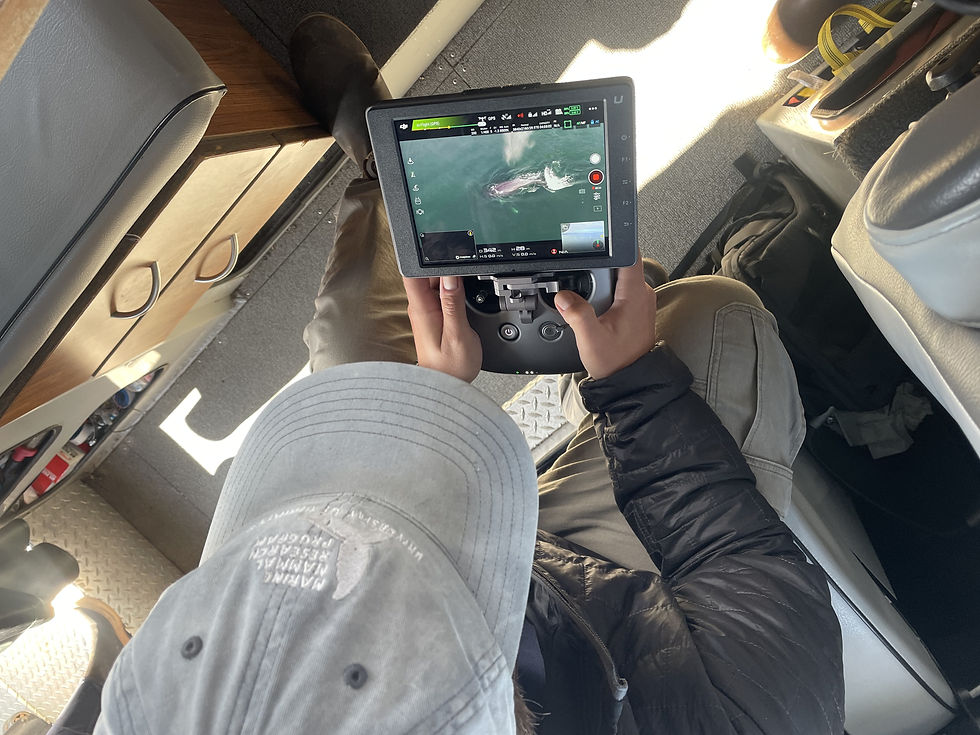Alaska Whale Foundation Research Report: July, 2023
- AWF Team

- Aug 7, 2023
- 3 min read

Month at a Glance:
Effort:
Days on the water: 10
Sampling stations: 103
Total # IDs: 251
Drone flights: 3
Biopsies: 1
Nutrient samples: 99
CTD casts: 103
Whale Poop: 0
Whale Numbers:
Number of unique whales: 185 (Total for year: 285)
Number of cow-calf pairs: 4 (Total for year: 10)
Bubble-netting groups: 5
Number of unique bubble-netters: 36 (Total for year: 95)

Above: Distribution of humpback whales photo-identified during July 2023. Size of red circles reflects group size (smallest circle = 1, largest = >16 whales). Triangles represent locations of surveyed “Point Count” stations for estimating whale abundance; these provide an indication of where photo-identification efforts were conducted (and, due to weather, were not).

Above: Average chlorophyll concentration (mg/m^3) in the top 20 m of the water column, measured at survey stations in July.
Research Overview:
July was our second full month of field work. Weather for conducting surveys was better than in June and the field team were fully trained and motivated to get as much data as possible (and we were without a drone pilot for the month, so data collection went a bit faster than usual), so we were able to visit nearly all (103 of 108) pre-established survey stations.
The number of whales appeared to increase, with large aggregations feeding primarily in North and South Chatham Strait and central Frederick Sound. Of the 185 whales we observed in July, only ~23% were seen in the previous month, eight were new to the AWF database and four were calves. Using publicly available data in happywhale.com, 85% of the whales we observed could be linked to breeding grounds. Of those, 91% have been observed in Hawaii, 7% have been observed in Mexico, and the remaining 2% have been observed in both Hawaii and Mexico. None have been observed in either the Central America or western North Pacific (i.e., Japan and Philippines) breeding grounds.
Most of the individual whales we encountered appeared to be feeding on krill, with some using bubble-nets that could be seen at the surface. The cooperative, herring feeding “bubble-netters” were observed on several occasions; however, the large aggregation observed in South Chatham in June appears to have dispersed into North Chatham/Icy Strait and central Frederick Sound.

The field team takes notes while conducting whale surveys.

The field team conducting a zooplankton tow during July's whale survey. The team is conducting a study this season to determine the feasibility of gathering zooplankton samples during routine surveys.

Bear cubs observed at the Hidden Falls hatchery during AWF's July whale survey. Bears and whales alike feed on the abundant fish that return to the hatchery every year.
About AWF's Field Work:
Each month from June through September, the AWF team visits up to 108 survey stations that are evenly distributed throughout the study region. At each station, the team conducts a 15min 'point count' and records the location of every whale they observed. At the same time, they deploy probes that measure ocean salinity, temperature and chlorophyll concentrations - the latter a proxy for phytoplankton biomass - from the surface to a depth of ~50m. They also collect water samples to measure nutrient concentrations. These data provide a detailed picture of the water column’s physical and chemical structure throughout the study region.
After completing the point count, the team then travels to each whale they observed to collect photo-identification images, launch Unoccupied Aerial Systems (“drones”) to measure the body volume of individual whales, and collect biopsy samples to measure hormone concentrations, stable isotope ratios (for reconstructing diet) and examine genetic profiles. Once all these data have been collected, the team travels to the next station and repeats the process. It takes a minimum of 9 days to complete each survey; however, it can take far longer if weather and whales are uncooperative.
About AWF's Research Reports
AWF aims to bridge the gap between scientists, stakeholders, and the public by communicating our general research findings through publicly available reports and information brochures. These reports provide up-to-date information on the status of Southeast Alaska humpback whales and are intended to serve as resources for local communities, stakeholders, policymakers, and educators.
Stay tuned for monthly reports during our field season from June-September, as well as an annual research report released every fall. You can also sign up for our newsletter below and visit this page to support AWF's research financially.



Our Dwarka Escorts Service is built on a foundation of trust and reliability. We ensure that every companion maintains the highest standards of professionalism and discretion, offering you a secure and truly enjoyable path to companionship.
D
Don't leave your evening to chance; ensure it's as exceptional as you are. A professional Delhi Call Girls provides the high-quality company you deserve, offering elegance, wit, and discretion. They are committed to making your time unforgettable, whether it's for social events or a private, relaxing encounter, always prioritizing your satisfaction.